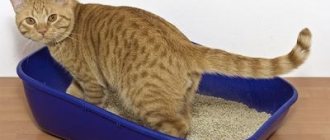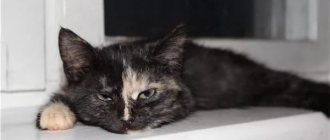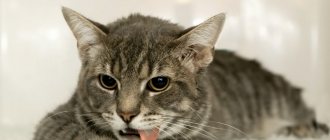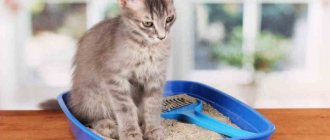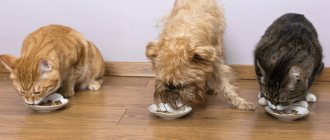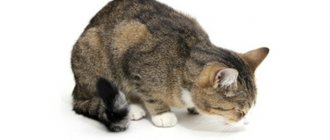Cats with diarrhea and vomiting are one of the most common complaints with which owners of mustachioed pets turn to the veterinarian. This can be an episodic phenomenon, for example, due to dietary errors, overheating of the animal, or it can be a symptom of serious diseases. Therefore, it is so important, after providing competent first aid to the animal, to immediately contact a veterinarian. Let's consider what can cause these digestive disorders?
Causes of vomiting and diarrhea
The occurrence of digestive disorders is most often associated with intoxication. Diarrhea and vomiting in kittens and adult animals are the body’s defense mechanisms that are necessary to get rid of irritants. In the process, toxins, foreign bodies, pathogens, etc. are released from the stomach.
Digestive disorders may be associated with the following reasons:
- Poor quality food. Poisoning can be caused by spoiled or inedible foods.
- Drastic menu change. Causes gastrointestinal irritation.
- Overeating or swallowing food too quickly. Whole pieces and large volumes of food negatively affect the mucous membrane.
- Accumulation of fur in the gastrointestinal tract. Lumps can cause a gag reflex and indigestion.
- Vaccination. May cause temporary discomfort.
- Allergy. The body tries to get rid of irritants.
- Viral and infectious diseases. The cat is vomiting due to the spread of pathogens and intoxication.
- Parasitic infection. Poisoning by toxins or severe infestation is possible, which causes a gag reflex.
- Inflammation of the gastrointestinal tract. With diseases of the intestines and stomach, the mucous membranes become sensitive.
- Tumors. The pressure of the formations can cause vomiting and diarrhea.
- Taking medications. Some drugs cause adverse reactions.
- Sunstroke. Nausea, diarrhea and disturbances in the functioning of the central nervous system are associated with moderate severity.
- Liver or kidney diseases. Due to inflammation and intoxication, tissue sensitivity increases.
The first 5 reasons most often cause short-term distress. Within a day the condition returns to normal. If diarrhea and vomiting persist for 24 hours or more, contact your veterinarian immediately.
Surveys
The list of studies depends on the pet’s medical history. If the appearance of loose stools is not associated with third-party pathologies, a specialist will conduct an examination and interview. It is advisable to tell the doctor about what the animal ate in recent days, whether there were changes in the menu, when the last vaccinations were given. It is recommended to take your pet's passport with you, which indicates the dates of the last vaccination and deworming treatment.
In general cases, a specialist will conduct a stool examination to detect pathogens and worm eggs. Additionally, it is necessary to do a blood and urine test to identify inflammation and its localization. An abdominal ultrasound may be performed to clarify the diagnosis. If the disease cannot be detected and the pet’s condition does not improve, tissue samples are taken for research. Additionally, X-rays and endoscopy are performed.
Urgent Care
You will definitely need it if, in addition to regurgitation and loose stools, serious additional symptoms appear that you need to remember and tell your doctor about:
- there are cramps, bloating, discharge from the eyes and nose;
- frequent stools - more than 4 times a day and with an unpleasant odor; the presence of pieces of undigested food, mucus or blood in it; vomiting with bile, white foam or it is transparent with saliva; the pet often meows due to pain;
- Activity and appetite have greatly decreased;
- complete refusal to eat and drink;
- started sneezing and coughing;
- body temperature has changed.
You should take him to the veterinary clinic, even if after a day or two it seems that it has become easier. After all, timely treatment can save lives!
Treatment of diarrhea
When the question arises about how to treat a cat, you first need to determine the cause of the deterioration in health. The state of the gastrointestinal tract can be normalized with the help of anti-inflammatory drugs and prebiotics. The latter improve local immunity due to the development of beneficial microflora. At the same time, antibiotics may be prescribed to kill pathogens.
If worms are present, anthelmintic drugs should be used, but their use in case of irritated stomach and intestines can aggravate the condition. In some cases, the veterinarian decides to temporarily cancel the procedure until symptoms resolve.
During treatment, be sure to change your diet and nutrition. In most cases, it is advisable to refuse food until the vomiting stops. This will help the body quickly cope with the ailment and prevent new urges. After the condition has stabilized, medicinal food is included in the menu. It is advisable to purchase canned food or pouches, since the granulated product contributes to insufficient fluid intake and can irritate the walls of the gastrointestinal tract.
Two-stage therapy
The specialist prescribes tests, as well as tests of vomit, feces, blood and urine to clarify the diagnosis, and then prescribes treatment:
Nutrition corrections
The first day is no food, but only drinking water with additives for dehydration, then a therapeutic diet (approximately as described in the next part).
Use of medications
Antiviral serum with antibodies; antibacterial drug (at least 1 month); probiotics; dewormers; antispasmodics; injections or droppers for dehydration (drinking water with Regidron); sorbent to cleanse the body of toxins; herbal medicines; decoctions of chamomile or oak bark for inflammation and disinfection.
How to help a cat with vomiting and diarrhea
Feeding during diarrhea and vomiting should be avoided for up to 12-24 hours. Fasting for 2 days can provoke the development of liver diseases, but short-term refusal of food helps relieve inflammation.
It is necessary to wash the water bowl thoroughly without using detergents. If infected, the fluid may contain pathogens. The pet must have 24/7 access to water. If the animal refuses to drink, it is acceptable to give it small portions on its own to prevent dehydration. The fluid should be given little by little, but often, so that vomiting does not recur.
You can give your pet Phosphalugel. This is a human drug that relieves irritation of the mucous membranes and helps neutralize the negative effects of acid during prolonged refusal of food.
The question of what to do at home for diarrhea and vomiting makes sense if it is impossible to get to the veterinarian. Symptoms that persist for a long time can be fatal due to dehydration, so it is important to consult a doctor promptly.
Chronic diarrhea: what is it?
When describing diarrhea, breeders can only identify visible symptoms, such as foul-smelling and frequent bowel movements, poor health of the cat or dog, and external changes. But in fact, chronic diarrhea is a complex syndrome, observed over 2-3 weeks, which includes a lot of invisible aspects, sometimes difficult to diagnose.
At the first stage of the examination, it is important to understand whether acute or chronic diarrhea is present. This is important, since in acute conditions it is enough to conduct a series of standard laboratory tests, relieve the syndrome and prescribe supportive symptomatic therapy.
In chronic cases, everything is not so simple! The main thing is to find the “focus” due to which regular diarrhea occurs and prescribe etiotropic therapy.
At the second stage, you need to figure out whether the diarrhea is small intestinal or colonic, or of mixed origin.
Clinical observations in chronic diarrhea:
- no weight loss (colic diarrhea). As an exception, weight is lost, but then streaks of blood and mucus are present in the stool (severe course);
- changes in body condition or severe weight loss (small intestinal diarrhea).
Important! The impact of protozoa on the intestines should not be ruled out. In particular, Giardia, which “loves” the small intestine. And trichomonas, which cause symptoms of chronic diarrhea in cats, settle in the large intestine and do not respond to standard drugs against Giardia (Fenbendazole, Metronidazole, Albendazole).
Prevention
To prevent nausea and diarrhea, the following measures should be taken:
- Carry out parasite treatment according to schedule. The drugs are given to animals at least every six months. If your pet eats meat or goes outside, the procedure should be carried out once every 3 months.
- Switch your cat to natural food or buy high-quality food. The diet should be balanced. Super-premium or holistic products are suitable for continuous feeding.
- Do not mix several types of food. A cat's stomach quickly gets used to digesting one type of food. Combining different types of food (especially in one feeding) or adding supplements will cause digestive upset.
- Maintain good hygiene. Bowls must be clean. When eating natural food, leftovers must be removed immediately to prevent poisoning and bacterial growth.
- Do not suddenly switch your cat to another diet. The transition should be carried out gradually, over 10-14 days.
- Minimize interaction with other animals. Outdoor cats can cause your pet to become infected.
If your cat sometimes burps in the morning or after eating, you should contact your veterinarian promptly. This may be a sign of the initial stage of the disease. Even in the absence of a pathological cause, irritation of the gastrointestinal tract can provoke the occurrence of disorders.
All information posted on the site is provided in accordance with the User Agreement and is not a direct instruction to action. We strongly recommend that before using any product, you must obtain a face-to-face consultation at an accredited veterinary clinic.
Diagnostics
Taking an anamnesis plays a huge role in determining the severity of the disease. When interviewing the owner, you need to find out the following:
- duration of diarrhea;
- localization - there is a focus of inflammation in the small or large intestine;
- predisposing factors - improper feeding, past illnesses, antibiotic treatment;
- concomitant pathologies - viral or bacterial infections.
The following examination methods are also used for diagnosis:
- Examination - reveals external signs of the underlying pathology. With thyroidism, for example, the motor function of the gastrointestinal tract is impaired, which is manifested by diarrhea and weight loss.
- Palpation - allows you to detect the accumulation of gas in the intestinal loops, neoplasms, intussusception, enlarged lymph nodes, ascites.
- Microscopy of stool for worm eggs is necessary if the doctor suspects a helminthic infestation.
- Bacteriological analysis - diagnosis of intestinal infections.
- Complete blood count shows anemia, leukopenia, eosinophilia.
- Blood biochemistry - determination of dysfunction of internal organs.
- Serological analysis - detection of viral leukemia, immunodeficiency, coronavirus, toxoplasmosis.
- Contrast radiography shows intussusception, obstruction, and neoplasms.
- Endoscopy or laparotomy - visual examination and obtaining a biopsy.
White foam vomiting in cats: treatment
Depending on the reason that caused the regurgitation of food, various measures must be taken. If it has been established that the animal was rummaging through waste or eating indoor plants, then these factors should be eliminated: limit access to plants, store garbage in places that are difficult for the animal to reach. Starting a new diet can also cause vomiting. In such cases, the regurgitated material will not have any impurities, the discharge will be single and not abundant. Such vomiting of white foam in cats does not require specialized treatment.
If your pet tries to eat an indigestible product or third-party objects (Christmas tree decorations, rubber products, etc.), then you should carefully monitor the animal’s condition. Such objects can cause obstruction and lead to serious complications. In this case, the animal will need surgery. For diagnosis, you can use ultrasound or x-ray with a contrast agent.
If vomiting is repeated, the evacuation of the stomach contents occurs like a fountain, the presence of impurities (blood, bile, feces) is determined, a foul odor appears, the animal is exhausted, it is necessary to seek specialized help. It is necessary to limit food intake so as not to provoke a gag reflex, but provide the animal with free access to fresh water. In cases of repeated and profuse vomiting, dehydration becomes a serious threat to the pet's life. But you should not force the animal to drink. In cats with severe conditions, maintenance therapy should be carried out - intravenous administration of solutions, administration of antiemetic and analgesic drugs, monitoring of electrolyte balance.
The number of pathological conditions leading to vomiting is very large. Regurgitation of white foamy liquid can be either a harmless sign (regurgitation of a hairball with the capture of gastric mucus and its foaming due to the entry of air in the process), or a consequence of a serious disease that requires immediate surgical intervention (obstruction, peritonitis). Therefore, if you vomit repeatedly, you should immediately contact a veterinary clinic for diagnosis.
Why?
We will talk today only about the age period, starting from 2 months (and up to 1 year), because it is at this moment that kittens are most often “given into good hands,” that is, they are taken, firstly, from their usual home environment and, secondly, they change the diet, thereby violating the 2 main “strongholds of health” of the baby.
So, digestive disorders in kittens at this age occur much more often than in adult cats (and they are more dangerous!), because the gastrointestinal tract is still “learning” to work, like the whole body, it is rapidly growing and forming. The immune system is also gaining strength.
And we need to learn: to be able to recognize the two main “provocateurs” of this problem.
The first of them: conditions of detention:
- as a result of inattentive or illiterate care for pets;
- when weaning from the mother too early, and even if not early, feeding instead of milk with food that the baby’s weak intestines cannot yet absorb.
Second: diseases and pathologies.
Let's consider both cases in detail.
Treatment of the underlying disease
The main specific treatment can be started only after an accurate diagnosis has been established, and what to do, which drug to choose and dosage, must be decided by the veterinarian. Possible treatment regimens are as follows:
- For bacterial infections, antimicrobial drugs of gastrointestinal and systemic action are prescribed. Since pathogenic microflora kills the natural one, probiotics containing beneficial microorganisms are prescribed.
- When infected with intestinal parasites, anthelmintics are prescribed. You will have to drink them 1-2 times, due to the fact that parasites often have a complex development cycle. The drug is selected based on the type of parasite.
- For inflammatory processes (gastroenteritis, pancreatitis and others), systemic non-steroidal anti-inflammatory drugs are prescribed. At the same time, enzymatic preparations are prescribed to facilitate the functioning of the liver and pancreas.
- When there is a blockage in the intestines, surgery is performed first. After this, the veterinarian prescribes antibiotics to eliminate the risk of infection, as well as enzyme preparations, and later prescribes probiotics to restore the microflora.
- In case of hormonal imbalance , hormonal medications are necessarily prescribed, and you will most likely have to take them for the rest of your life. But a complete recovery is also possible, provided that the cause of the hormonal imbalance can be eliminated.
